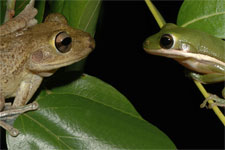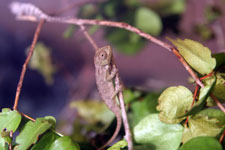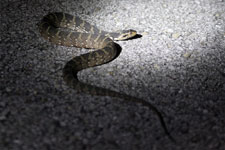Everglades Invasive Reptile and Amphibian Monitoring Program
South Florida's subtropical climate and mosaic of natural, agricultural, and urban habitats make the region vulnerable to biological invasions. In particular, the recent explosion of nonnative reptile and amphibian species is a growing threat to natural ecosystems. Burmese pythons and Cuban tree frogs are already established in some of the remotest areas of the Everglades, while Nile monitors, yellow anacondas, tegu lizards, and spectacled caiman have all been recently found in the area. Methods to control these invaders have not kept pace with the increasing risk. A monitoring program for nonnative reptiles and amphibians is needed to understand the characteristics and impacts of these invaders to help develop the most effective control methods.
The Everglades Invasive Reptile and Amphibian Monitoring Program (EIRAMP) aims to determine status and spread of invasive reptiles and amphibians on lands within the Everglades Cooperative Invasive Species Management Area (ECISMA). At the same time, EIRAMP also surveys for native reptiles, amphibians, and mammals. Visual and vocal surveys are conducted throughout the ECISMA following standard routes along roads, levees, and canals within natural areas. Locations of invasive and native species are recorded using a global positioning system, and invasive species are removed when possible. After capturing the invasive animals, we collect further data on their diet, condition, sex, and reproductive status. Results are applied to enhance removal of invasive species and to determine impacts of invasive species on the native wildlife of the Everglades.
Images
Fact Sheets
The Invasion Curve: A Tool for Understanding Invasive Species Management in South Florida (PDF)
Nonnative Reptiles in South Florida: Identification Guide (PDF)
Select Publications
Mazzotti, F.J., McEachern, M., Rochford, M., Reed, R.N., Eckles, J.K., Vinci, J., Edwards, J., Wasilewski, J. 2014. Tupinambis merianae as nest predators of crocodilians and turtles in Florida, USA. Biological Invasions DOI 10.1007/s10530-014-0730-1. Full PDF
Fujisaki, I., K. M. Hart, F. J. Mazzotti, K. G. Rice, S. Snow, and M. Rochford. 2010. Risk assessment of potential invasiveness of exotic reptiles imported to south Florida. Biological Invasions 12(8): 2585-2596. Full PDF
Mazzotti, F.J., M.S. Cherkiss, K.M. Hart, S. Snow, M.R. Rochford, M.E. Dorcas, and R. Reed. 2010. Cold-induced mortality of invasive Burmese pythons in south Florida. Biological Invasions 13(1):143-151. Full PDF
Links
Everglades Cooperative Invasive Species Management Area (ECISMA)







